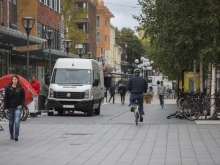
Sweden
Sweden is one of the largest countries in Europe in relation to the surface. In Sweden live about 9.7 million people, about 23% are younger than 20 years and about 15% of the population were born in another country. In Sweden today lives about 85% of the population in towns and cities, a proportion that is steadily increasing. The ongoing strong urbanisation trend presents both challenges and opportunities, and the cities are becoming more and more important to create conditions for regional growth, energy and resource efficiency, human well-being and sustainable development of society at large.
Three mayor urban areas
Sweden’s urban population is concentrated in three mayor urban areas. The capital Stockholm at the east coast is the largest city with about 900,000 inhabitants. The city of Gothenburg at the west coast is the second largest city with about 540,000 inhabitants and the city of Malmö in the south of Sweden with about 300,000 inhabitants is the third largest city. The city of Malmö is also connected to the city of Copenhagen, the capital of Denmark, with the Øresund link (bridge and tunnel).
Swedish Urban Development Platform
The government gave in February 2014 a mission to five agencies, the National Board of Housing, Building and Planning, the Swedish Energy Agency, the Swedish Environmental Protection Agency, the Swedish Agency for Economic and Regional Growth and the Swedish Transport Administration, to establish and manage a platform for issues of sustainable urban development. The platform builds on the special initiative the government had between 2008 and 2012 to promote the sustainable development of cities, towns and neighbourhoods—the Delegation for Sustainable Cities.
Purpose and challenges
The purpose of the platform is increased collaboration, coordination, knowledge sharing, dissemination and exchange of experiences in sustainable urban development. Some of the challenges which are known today is such as lack of coordination within and between sectors and levels of government, inadequate investment in research and development of knowledge and a gap between sustainability rhetoric and practice. The state has an important role in strengthening cooperation between sectors and levels. The platform is an important link between practice and policy at local, regional and national levels. The platform will also provide a process support for the regional structural fund programs work on sustainable urban development.
In Sweden so far 13 cities, communities and regions have take part in more than 20 different URBACT networks. Those experiences are now important in the development of the Swedish URBAN Development Platform.
SOME RELATED NETWORKS
BeePathNet Reloaded
Com.Unity.Lab
CTUR
National URBACT Points
Article
Making integrated urban development more manageable
Article
Gothenburg’s new app for education
Article
A new urban freight plan
News
'Cities in Action-Stories of Change’ publication just released!
Article







